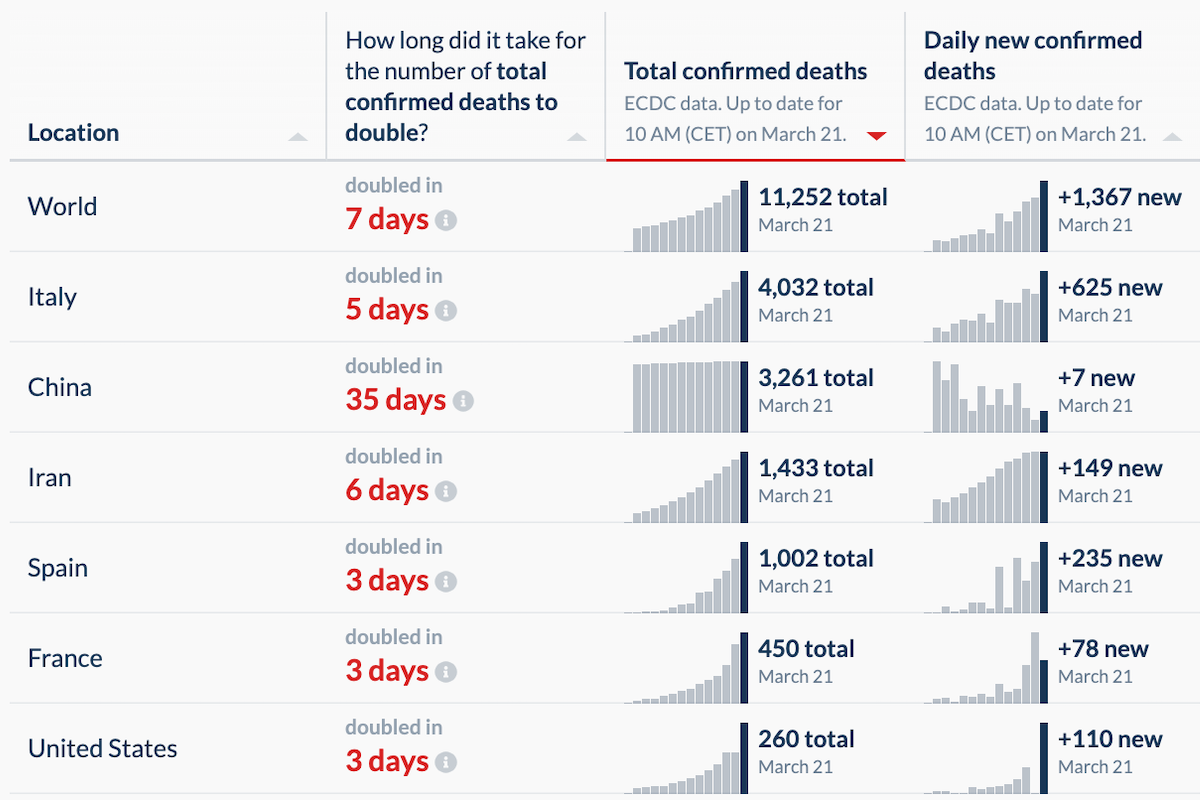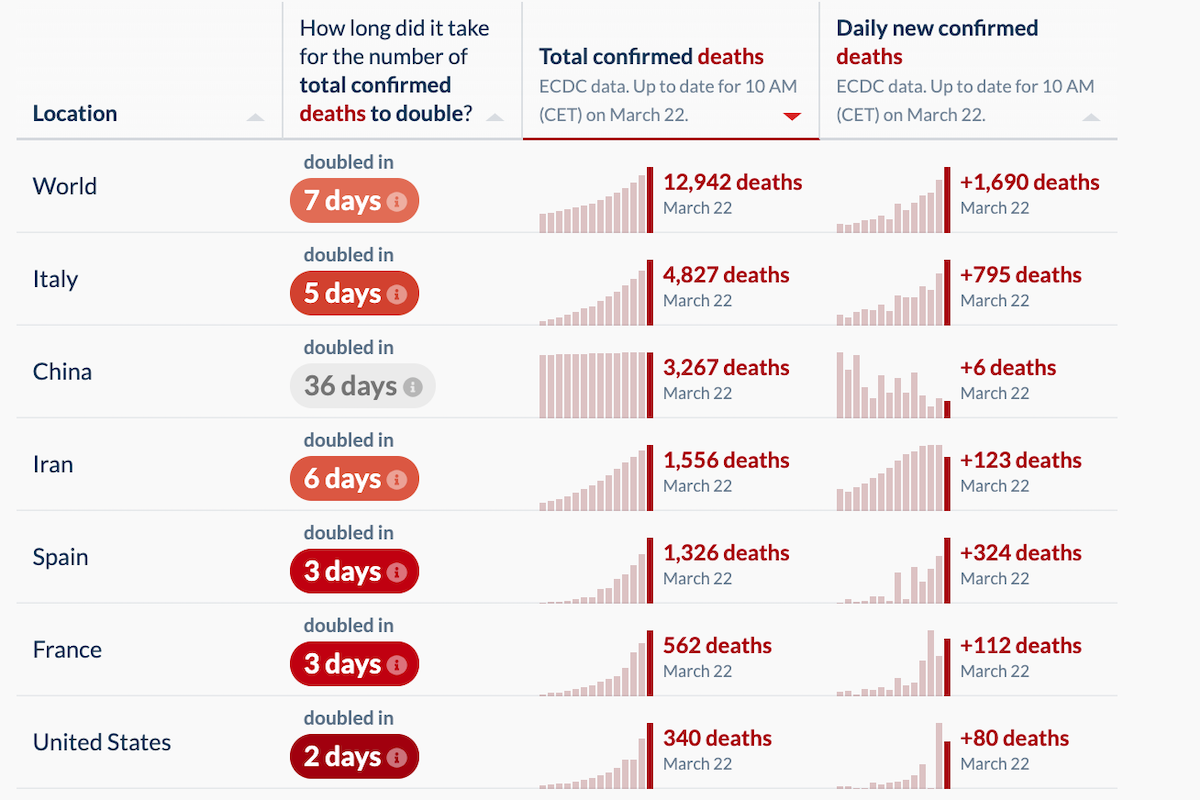COVID-19 Updates
COVID-19 Science Update for March 21st: What Is Germany Doing Right?
There are reports of ventilator shortages, and the possibility of an Italian-style horror show, with doctors deciding whose parents live and whose parents die, seems real.

The latest global data for COVID-19—updated with reports received on March 21st, 2020—have been published at Our World in Data. Here are some of the numbers and trends that I believe deserve special attention, as well as a brief report on notable regional developments and media analyses. Beginning today, these updates will be published at Quillette in our section marked COVID-19 UPDATES. Please report needed corrections or suggestions to [email protected].
Yesterday’s global tally of confirmed new cases to date was 271,364. This represents a daily jump of 28,891. The previous daily jumps were, proceeding backwards, 29K, 19K, 15K, 12K, and 14K. As has been the case in recent days, the lion’s share of new cases came from just these five countries, which accounted for 74 percent of all new global confirmed cases yesterday:
- France (1.6K new cases, as compared to 1.9K, 1.4K, and 1.1K in the days previous)
- Germany (4.2K new cases, as compared to 5.9K, 1K, and 1.1K in the days previous)
- Italy (6K new cases, following on almost equally massive jumps of 5.3K and 4.2K)
- Spain (2.8K new cases, compared to 3.4K, 2.5K, 2K, 1.4K, 2K, 1.5K, and 1.3K in the week previous)
- United States (5.4K, 4.8K, 3K, and 1.8K in the previous four days).
Obviously, it would be great to see the new-case data flatten and even decline. But the reporting I’ve seen continues to suggest that focusing on new cases can be misleading, since different countries are identifying (and confirming) vastly different proportions of their national caseloads. South Korea, China, and Germany all have tested on a huge scale—a practice that corresponds with relatively high case numbers, but also low observed case-fatality numbers, since thorough testing regimes sweep in mild and asymptomatic cases, and not just the severe and critical ones. (A New York Times report indicates that some of the countries that made an early decision to engage the private sector in testing solutions, such as Australia, South Korea, and Singapore, have been the most agile and effective in testing their citizenry. In New South Wales, Australia alone, 33,000 people have been tested—more than had been tested in all of Canada as of March 15th.)
One of the strange things about this illness is that some of the wealthiest and most well-organized societies in the world are having so much trouble isolating patients and stopping the spread. Belgium, for instance, had 462 new cases yesterday—up from 309 and 243 in the previous two days. The Netherlands now has about 3,000 cases, having reported 534 new cases yesterday (up from 409 and 346 in the previous two days). And Switzerland had almost 1,000 new cases yesterday. Meanwhile, if the reported data is to be believed, much poorer, densely populated countries such as Vietnam and Malaysia seem to be controlling, if not suppressing, their outbreaks.
Canada, where I live, had 125 new case reports yesterday. That’s roughly on par with the previous four days, which suggests a possible plateau amid this week’s lockdown. But there is confusion about how credible our numbers are, since we are testing relatively few people, and there have been widespread complaints about delays and screw-ups. Meanwhile, Denmark’s numbers also have been stabilizing (though that country also has tested relatively few people, and has relied mostly on a trust-based system of self-isolation). Sweden and Norway also seem to be plateauing. The UK reported 706 new cases yesterday, up slightly from 647 and 680 in the previous two days. If these UK numbers continue to plateau over the next week, it will mean that Boris Johnson’s belated but decisive shift into lockdown mode will have averted an Italian-style meltdown.

There were 1,367 new coronavirus deaths reported globally yesterday, bringing the cumulative total to 11,252. Almost half of these—a shocking 625—were in Italy (546 of them in Lombardy). Iran reported 149, Spain 235, and there were 110 in the United States. Germany, which had been walking on water death-wise, reported 30 two days ago, after having reported just 13 cumulative deaths before that. Yesterday, Germany reported just two new deaths, bringing its total to 45. Obviously, deaths trail new cases. But it’s already been two weeks since Germany reported its 1,000th case. By comparison: By the time two weeks had passed following Italy’s 1,000th reported case on March 1st, more than 1,000 Italians had died.
Because the situation in each country is different, it’s hard to take an international perspective that goes beyond simply looking at the numbers. But there are important stories worth highlighting from the nations where the outbreak is worst.
It’s become apparent, for one thing, that the United States is going to have a difficult time suppressing its outbreak, because its political leadership has been extremely weak, and because states and cities are adopting a mix of conflicting policies (though, gratifyingly, the trend in the most affected areas is toward lockdown). It also seems that New York State is becoming the Lombardy of the United States, with 8,000 positive tests—about half of all U.S. confirmed cases. There are reports of ventilator shortages, and the possibility of an Italian-style horror show, with doctors deciding whose parents live and whose parents die, seems real.
On the science front, many readers probably have seen articles suggesting that common malaria drugs such as chloroquine may be effective against COVID-19. Preliminary published research in this area goes back at least to early February, but I am yet to find anything solid showing that front-line doctors now see this as a promising treatment option.
Finally, on the crucial subject of COVID-19’s fatality rate, Jason Oke and Carl Heneghan have written a short (not yet peer-reviewed) paper for Oxford University’s Centre for Evidence-Based Medicine. As many readers know, the observed case fatality rate for COVID-19 has been as high as 17 percent among the first detected cases in China, but then came in at closer to 0.7 percent in both China and South Korea, as milder cases were detected through aggressive testing. Oke and Heneghan suggest that the real rate is closer to 0.125 percent because so many mild cases are still going undetected.
To put that figure in context: If that number were accurate, this would mean that if every Canadian got the disease (once), something like 45,000 people would die. If, on the other hand, the originally reported figure of 3 percent were accurate, something like a million Canadians would die. In the United States, a 0.125 percent case fatality rate applied to the entire population would yield about 400K deaths.
The authors also have an interesting digression on the swine flu. In the midst of that epidemic, they note, the death rate was estimated at 0.1 — 5.1 percent. The actual death rate turned out to be 0.02 percent.
My concern is that that paper was written off of March 17th data, and the authors’ rosy case-fatality-rate estimate is based in large part on German data. But the German death rate surged two days after March 17th (as noted above). Even so, the available data does suggest that, outside of Italy at least, this disease is not quite as deadly, on a case by case basis, as first feared.






